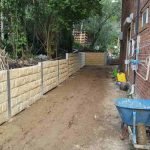Introduction
Building a keeping wall is more than just stacking stones or putting wood; it's an art that blends engineering principles, style aesthetics, and practical performance. As we look into From Concept to Conclusion: A Day in the Life of a Retaining Wall Builder, you'll find the complexities associated with this fascinating occupation. Whether it's managing concrete sleepers, H beams, or lumber sleepers, every element plays an essential role in ensuring that the Tuff Stuff Retaining Walls structure not just looks great however also stands the test of time.
What is a Keeping Wall?
A retaining wall is a structure created to hold back soil and avoid disintegration on sloped surfaces. These walls are essential for maintaining landscape stability and can be made from different products such as stone, wood, and concrete.
The Function of a Retaining Wall Installer
A retaining wall installer is responsible for transforming strategies into concrete structures. They work closely with architects and landscape designers to ensure that the finished item meets both functional and aesthetic criteria.
Understanding the Various Kinds of Retaining Walls
Concrete Sleepers
Concrete sleepers are pre-cast blocks utilized for their robustness and toughness. They supply excellent support for heavy loads and are resistant to rot and pest damage.
H Beams
H beams offer considerable structural assistance due to their shape, making them perfect for taller keeping walls where extra strength is required.
Wood Sleepers
Though visually enticing, wood sleepers require regular upkeep due to their susceptibility to decay. Nevertheless, they can supply a warm visual that blends well with natural landscapes.
Timber Sleepers
Timber sleepers are often used in residential projects where less height is required. They can create a rustic appeal however come with issues about longevity.
Stone Maintaining Walls
Stone walls are timeless and can add enormous value to homes. Their natural look makes them popular in landscaping designs however needs experienced craftsmanship for appropriate installation.
The Initial Consultation: What Takes Place First?
During the preliminary consultation phase, a retaining wall contractor consults with clients to discuss their needs and preferences. This stage involves website assessments, understanding drainage issues, and determining product choices.
Planning & Style Stage: Crafting the Blueprint
Once preliminary discussions conclude, comprehensive blueprints are created. This plan includes measurements, product specs (be it concrete sleeper or stone), and drain solutions.
Permits & Regulations: Navigating Legalities
Before building and construction begins, protecting essential permits is important. Building regulations vary by place; hence comprehending local policies ensures compliance throughout the project.
Preparing the Website: Clearing & Excavation Work
Preparing the website involves cleaning plants and debris followed by excavation work. This step lays the structure for a structurally sound keeping wall.
Material Selection: Choosing The Right Components
Selecting products aligns closely with style goals while also thinking about budget restraints. Aspects like resilience (concrete vs. timber sleeper) play a necessary function in this decision-making process.
Foundation Work: The Importance of Stability
A solid foundation is non-negotiable when developing any retaining wall. Whether using H beams or stone, ensuring stability prevents future collapses or shifts.
Construction Process: Detailed Execution
Lay Out The Plan
Utilizing stakes and string lines helps visualize where each element will go.
Excavate For The Base
Digging makes sure that water will drain pipes appropriately away from the wall.
Install Drain Solutions
Appropriate drainage systems avoid soil saturation behind walls.
Constructing The Wall
Depending upon chosen materials (like concrete sleepers), walls might be developed layer by layer.
Backfilling
As soon as installed, backfilling assists support the structure while guaranteeing sufficient drainage.
Finish Work
Adding any preferred functions like caps or ornamental aspects finishes the look.
Tools of The Trade: Necessary Equipment For Builders
Having a selection of tools at your disposal makes all jobs easier:
- Shovels & & Picks Levels Compactors Trowels Power Tools
Quality Control Steps During Construction
Quality control guarantees that every aspect fulfills market standards:
- Regular Inspections Material Testing Adherence To Plans
Addressing Difficulties On-Site: Problem-Solving Skills Required
No building job goes off without a hitch! From unanticipated weather condition modifications to material scarcities-- being versatile is key!
Final Touches: Visual Enhancements For Your Maintaining Wall
After construction comes beautification:
Landscaping around it Adding plants or lighting Painting or staining wood structuresMaintenance Tips For Durability Of Maintaining Walls
To extend the life of your maintaining wall:
- Regularly check for cracks Clean debris Check drainage systems
Common Frequently asked questions About Maintaining Walls
1. What products are best for developing retaining walls?
Choosing in between concrete sleeper, stone, timber sleeper depends on visual preference and structural requirements.
2. How high can my keeping wall be?
Local policies determine height limitations; generally between 4-- 6 feet without special permits.
3. Do I require preparing permission?
In most cases yes; check local building regulations before beginning construction.
4. Can I install a retaining wall myself?
While do it yourself is possible, working with professionals ensures safety and compliance with regulations.

5. How do I maintain my maintaining wall?
Regular evaluations ought to concentrate on checking for cracks or drainage concerns; instant repairs enhance longevity!
6. Are maintaining walls expensive?
Costs differ based upon materials picked(e.g., wood vs stone)along with labor expenses involved.
Conclusion
In conclusion, building a keeping wall includes meticulous preparation from start to complete-- thus why understanding every action in this journey from principle through conclusion matters immensely! From choosing products like concrete sleepers or wood to browsing legal requirements-- it's clear how comprehensive this procedure genuinely is! So next time you see one standing high versus nature's forces-- take a minute to value all that entered into developing it!